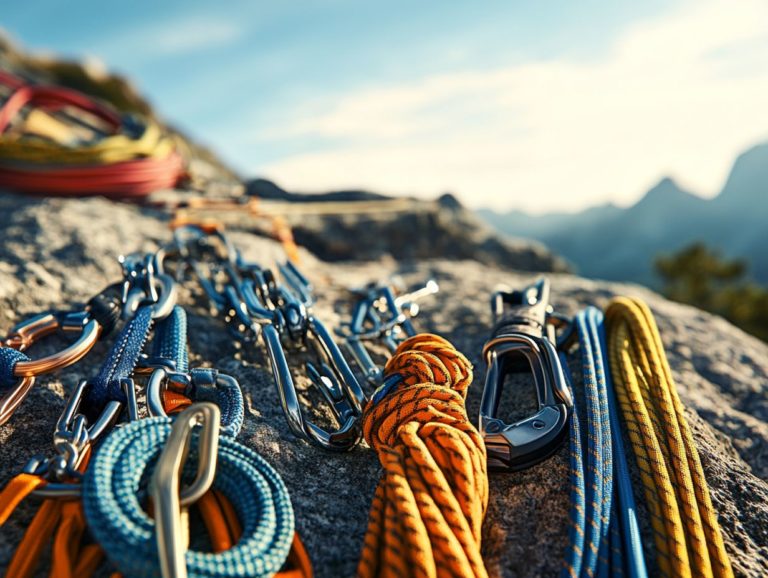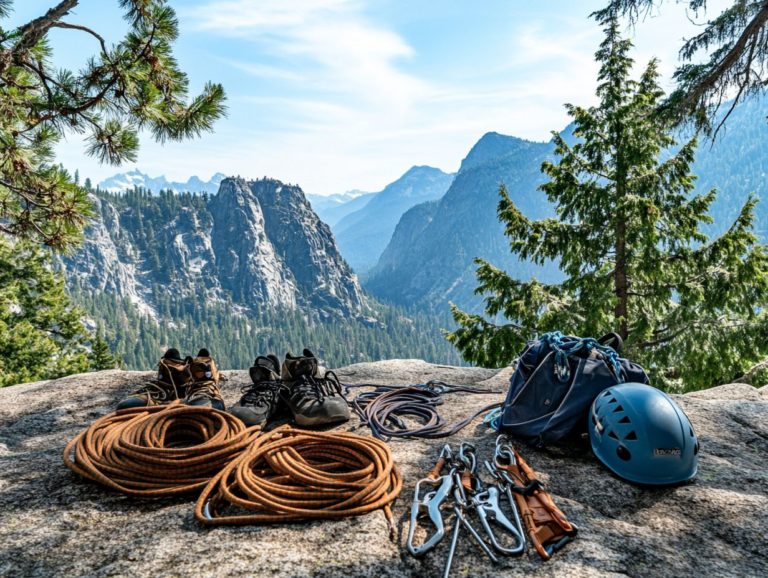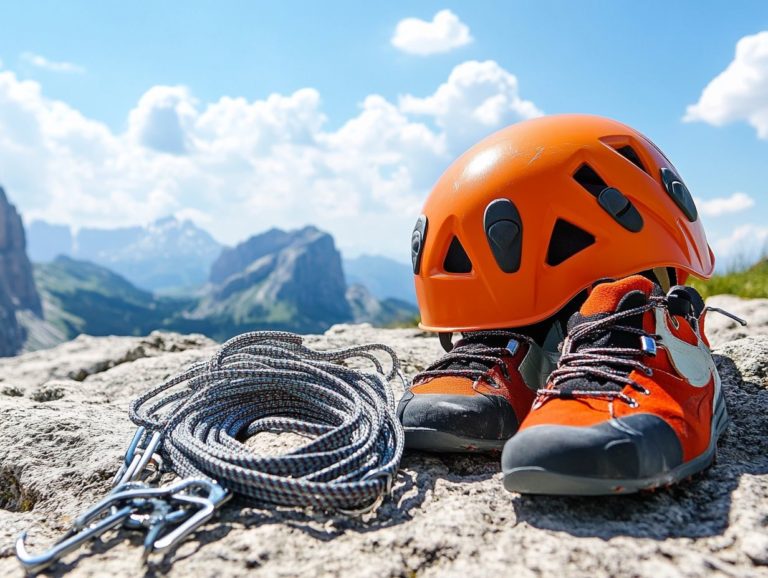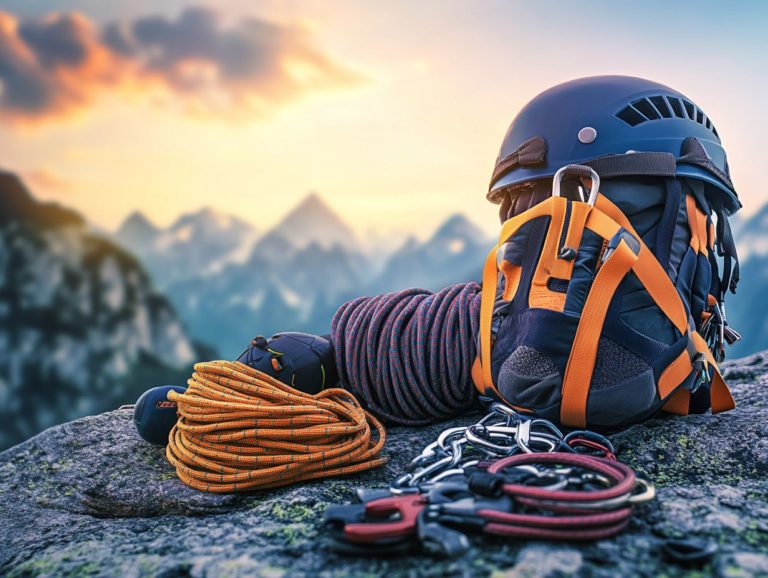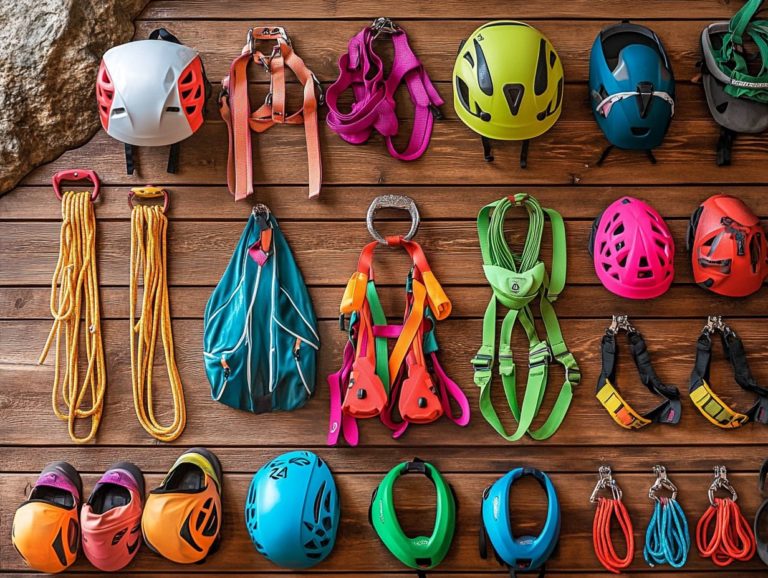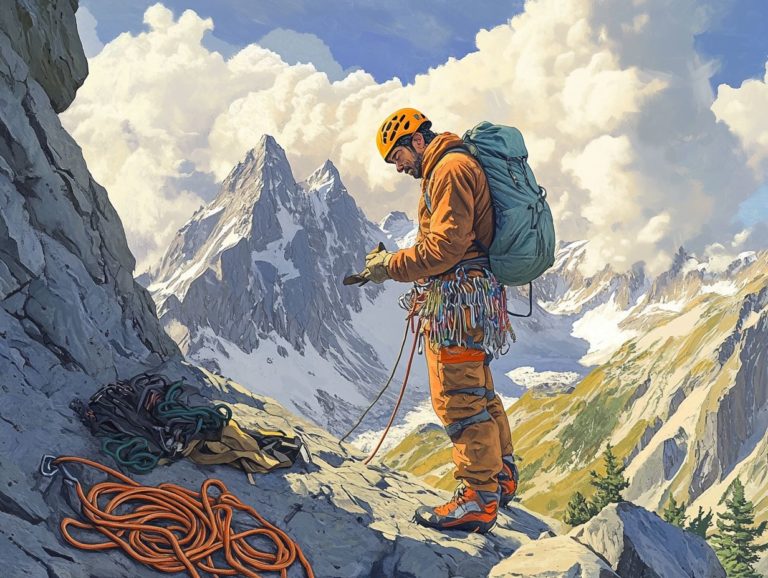How to Choose Between Different Climbing Ropes
Climbing ropes are an important safety tool for any climber. They serve as your lifeline during adventures, especially in rock climbing.
With many types available, choosing the right rope can feel daunting. This guide makes selecting a rope easy and fun!
It breaks down key types of climbing ropes and highlights important features to consider. You ll find insights on popular brands, models, and how to care for your rope.
Whether you re an expert or just starting, this guide helps you make informed choices. Get ready to elevate your climbing game!
Contents
Key Takeaways:
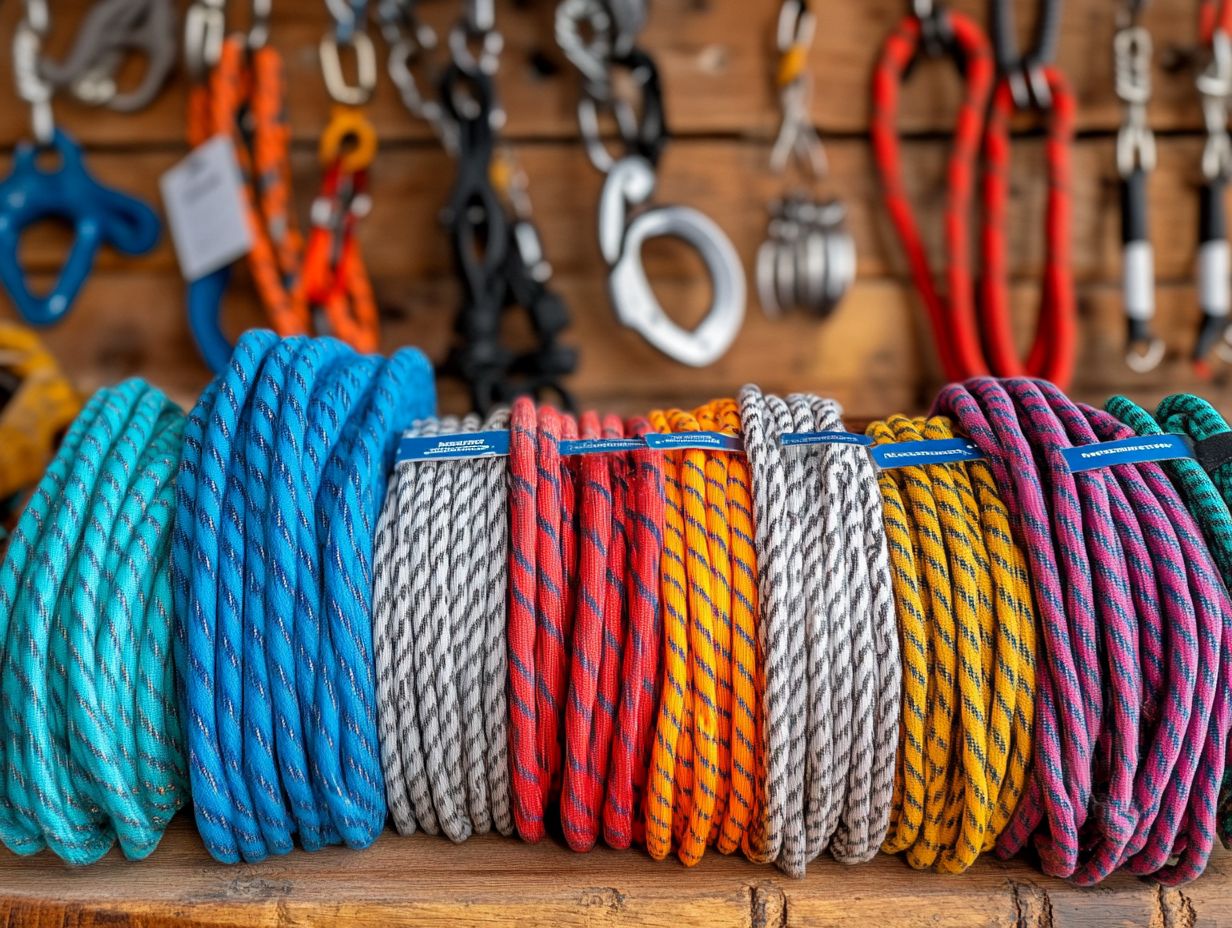
- Consider your climbing style and needs when choosing a rope.
- Compare brands and models based on features and customer reviews.
- Store and maintain your rope properly for safety and longevity.
Understanding Climbing Ropes
Understanding climbing ropes is essential, whether you’re new or experienced. The right rope enhances your safety and boosts performance on challenging routes.
There are different types of climbing ropes. Dynamic ropes absorb shock, while static ropes provide stability for rescue operations.
You’ll find features like kernmantle construction, which combines a strong outer layer with a flexible inner core. UIAA certification ensures quality, and specifications like rope length and diameter are crucial for effectiveness.
Grasping these elements is vital for managing your ropes and maintaining safety in the climbing community.
Types of Climbing Ropes
Climbing ropes fall into several categories. Dynamic ropes absorb shock during falls, making them ideal for lead climbing.
Static ropes are perfect for rescue operations where minimal stretch is necessary. Kernmantle ropes balance strength and flexibility, fitting various climbing needs.
For multi-pitch climbs, half ropes are invaluable. Twin ropes offer extra safety on lengthy routes.
Dynamic ropes are popular in lead climbing because they stretch and reduce impact force. Static ropes provide stability during caving or rescues.
Kernmantle ropes support both sport and traditional climbing techniques. Choosing between half ropes and twin ropes affects your weight and safety on complex routes.
Key Features to Consider
When selecting climbing ropes, consider essential features like rope length and diameter. These factors directly influence usability and safety. Other vital aspects include abrasion resistance and dry treatment for moisture protection, which ensure your rope’s durability and performance, especially in wear-prone environments. This underscores the importance of thorough rope testing and following rope safety standards, such as UIAA (International Climbing and Mountaineering Federation) and CE EN 892.
The type of rope construction, whether static or dynamic, is crucial for energy absorption during a fall. Dynamic ropes stretch under load, effectively reducing the force you experience if you fall. In contrast, static ropes are ideal for activities like rappelling or hauling gear.
Evaluate the rope’s weight and handling characteristics. Lighter ropes enhance mobility, but they may compromise durability if not chosen wisely. Familiarizing yourself with UIAA testing standards and certifications will help you select ropes that have undergone rigorous safety tests, ensuring dependable performance in critical situations.
Choosing the Right Rope for Your Needs
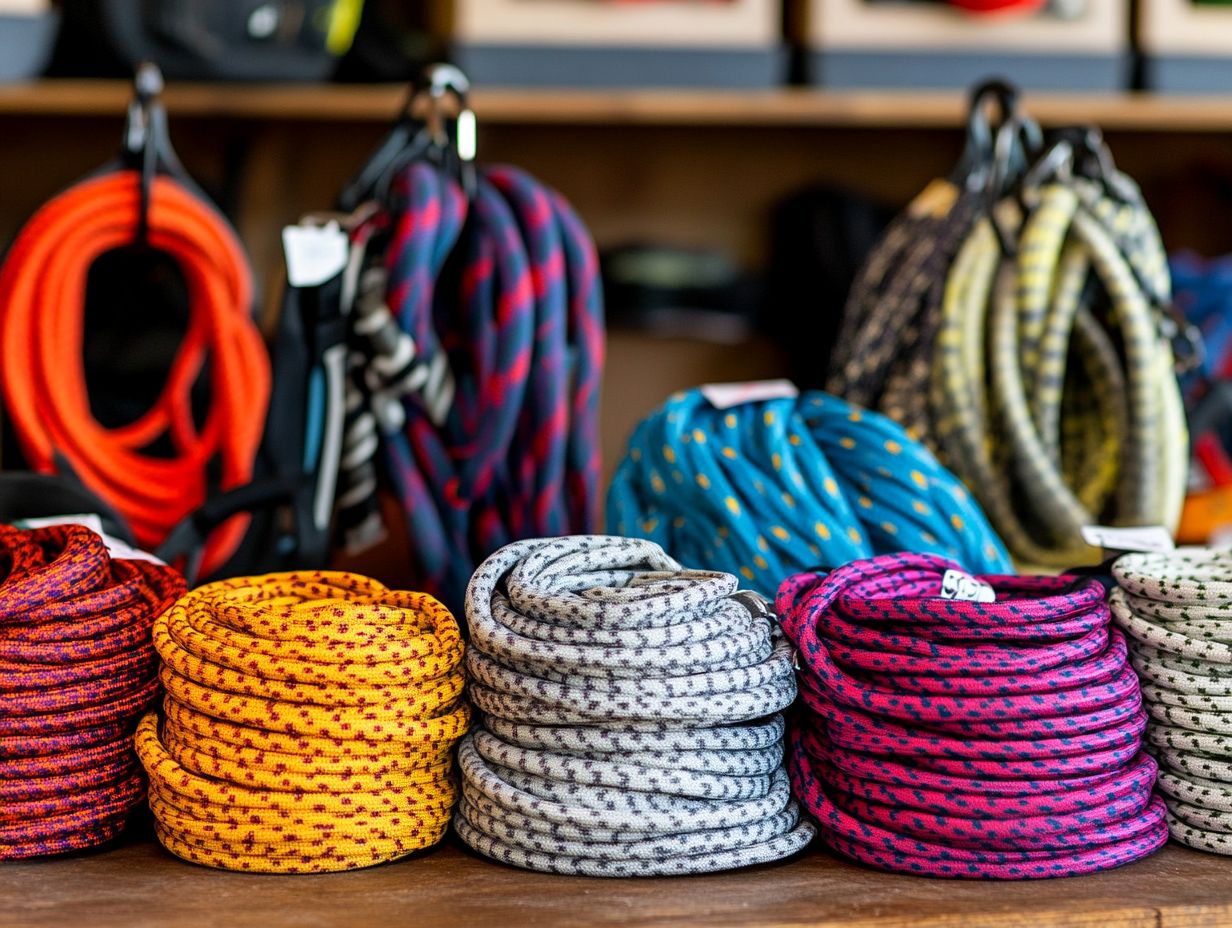
Choosing the ideal climbing rope tailored to your needs is an important choice that impacts your performance and safety on the rock. Think about your climbing styles whether sport climbing, traditional climbing, or alpine adventures and how these preferences dictate your rope choices.
Considerations like rope quality, intended usage, and the unique attributes of various ropes significantly enhance your safety and optimize your performance on demanding routes. For more insights, check out how to choose climbing gear for rock climbing.
Factors to Consider
Choosing a climbing rope? Let s look at the key factors that matter! Essential elements include the rope’s length and diameter, which affect your climbing techniques. Understanding the impact force generated during a fall and the different rope types available enables you to prioritize safety and effective rope management.
Evaluate the rope’s static and dynamic characteristics, as these directly affect performance under load. For instance, dynamic ropes are engineered to stretch and absorb impact forces, significantly reducing your risk of injury during a fall.
Never skip maintenance! Regularly inspecting your climbing gear for signs of wear and tear is crucial for ensuring its longevity and reliability. Consider the rope s durability in different weather conditions to enhance performance and safety in various climbing scenarios.
Matching Rope to Climbing Style
Matching your climbing rope to your specific climbing style is essential for maximizing both performance and safety. Dynamic ropes are your go-to for sport climbing due to their ability to absorb impact forces. Meanwhile, static ropes excel in scenarios like rappelling and rescue operations.
By understanding the distinct characteristics of these ropes, you can select gear that aligns perfectly with your climbing disciplines. This knowledge of what makes a great climbing rope ultimately elevates your climbing experience.
For example, when tackling multi-pitch routes, a longer dynamic rope provides the necessary stretch and durability for handling falls. Conversely, if you’re ice climbing or exploring unpredictable terrain early in the season, a static rope offers the strength and reliability needed for a safe descent.
Weather conditions also matter; whether it s wet or icy, certain rope types help minimize slippage and wear, ensuring climbing safety. By carefully choosing the right rope for each unique scenario, you’ll significantly boost your safety and enjoyment in your climbing adventures.
Gear up properly, and embark on your climbing adventure with confidence!
Comparing Different Brands and Models
Regarding climbing gear, comparing various brands and models of climbing ropes offers you invaluable insights into their quality, durability, and performance metrics. These are key aspects of climbing education. Premier brands like Edelrid, Black Diamond, and Trango present a diverse range of climbing ropes, each showcasing unique innovations designed to meet the specific needs of the climbing community, ultimately enhancing both safety and performance.
By evaluating the specifications and reputations of these brands, you can make informed decisions while selecting your essential climbing equipment, helping you understand the latest climbing innovations!
Top Brands and Their Unique Features
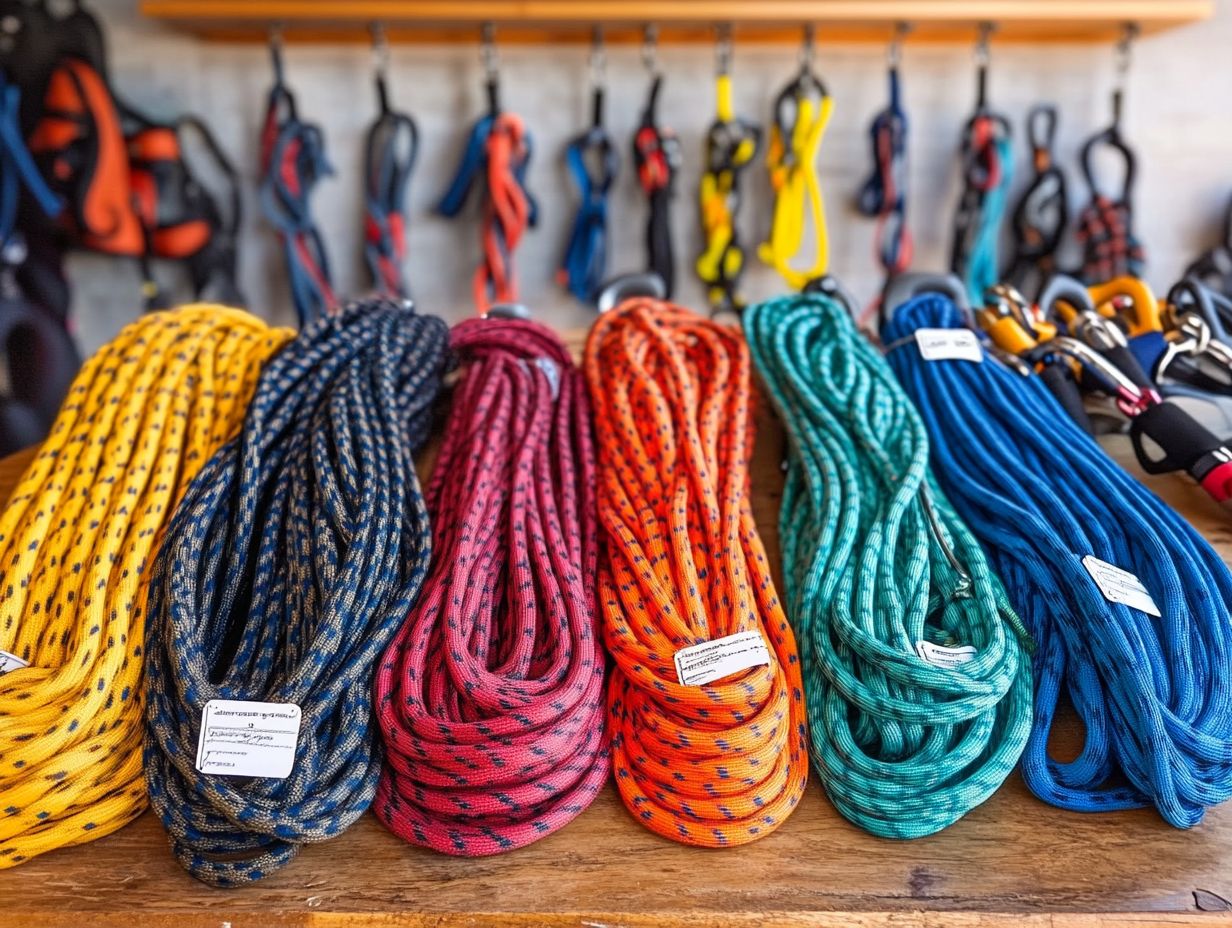
Top brands like Edelrid, Black Diamond, and Trango have established themselves as leaders in the climbing gear market. They offer ropes that showcase advanced technology and high-performance specifications, such as kernmantle construction a type of rope design that combines a strong inner core with a protective outer layer and optimal impact force ratings, which refer to how much force the rope can handle.
Take Edelrid, for example; they’ve developed a rope model with exceptional abrasion resistance and a unique dry treatment that dramatically reduces water absorption. This makes it perfect for those wet conditions you might encounter. Then there’s Black Diamond’s iconic Momentus Rope, which offers superb handling along with a low impact force ideal for sport climbers tackling challenging climbing routes. If you’re looking for more information on safety and comfort while climbing, check out this guide on how to choose the right climbing harness.
Meanwhile, Trango’s dynamic ropes are specifically crafted for trad climbers, focusing on minimal stretch to endure falls better, so you can tackle those tough ascents with increased confidence. By incorporating advanced materials and thoughtful engineering into their products, these brands not only enhance performance across diverse climbing environments but also prioritize your safety!
Customer Reviews and Ratings
Customer reviews and ratings are critical in the climbing community, providing crucial insights into the real-world performance and reliability of various climbing ropes and gear. These evaluations enable you to assess rope quality and safety, offering feedback on user experiences that can guide your purchasing decisions and ensure optimal climbing performance.
In a market where safety is paramount, the communal sharing of experiences becomes invaluable. For example, many climbers rave about brands like Petzl and Black Diamond, citing their durable and lightweight ropes that excel in handling dynamic forces during a fall.
On the flip side, negative reviews often highlight issues like fraying or inadequate grip, serving as cautionary tales for potential buyers. By scrutinizing trends in feedback, you can distinguish between products that meet stringent safety standards and those that don t. This enables you to make informed choices!
Ultimately, these shared perspectives enhance your decision-making process and cultivate a sense of trust within the climbing community.
Caring for and Maintaining Your Climbing Rope
Caring for and maintaining your climbing rope is crucial to ensure its longevity, safety, and performance during your climbing adventures. Use proper storage and cleaning techniques to enhance the durability of your equipment and promote safety by minimizing the risk of wear and damage.
This commitment contributes to a safer climbing environment for both you and the wider climbing community. Start taking care of your climbing rope today and enjoy safer climbs tomorrow!
Proper Storage and Cleaning Techniques
To keep your climbing rope in great shape, proper storage and cleaning are key. Store your ropes in a cool, dry place, away from direct sunlight.
Use specific cleaning methods to remove dirt and debris. This will significantly enhance the rope’s durability, which is vital for your safety.
Regularly inspect your ropes to catch any wear early. For cleaning, choose a mild detergent designed for climbing gear and rinse thoroughly to remove any residue.
After washing, let your rope air dry completely. Avoid heat sources that may weaken the fibers.
Always coil the rope properly instead of twisting it. A good coil prevents kinks and tangles, making storage easier.
By following these methods, you ll enhance durability and promote safety during climbs.
Frequently Asked Questions
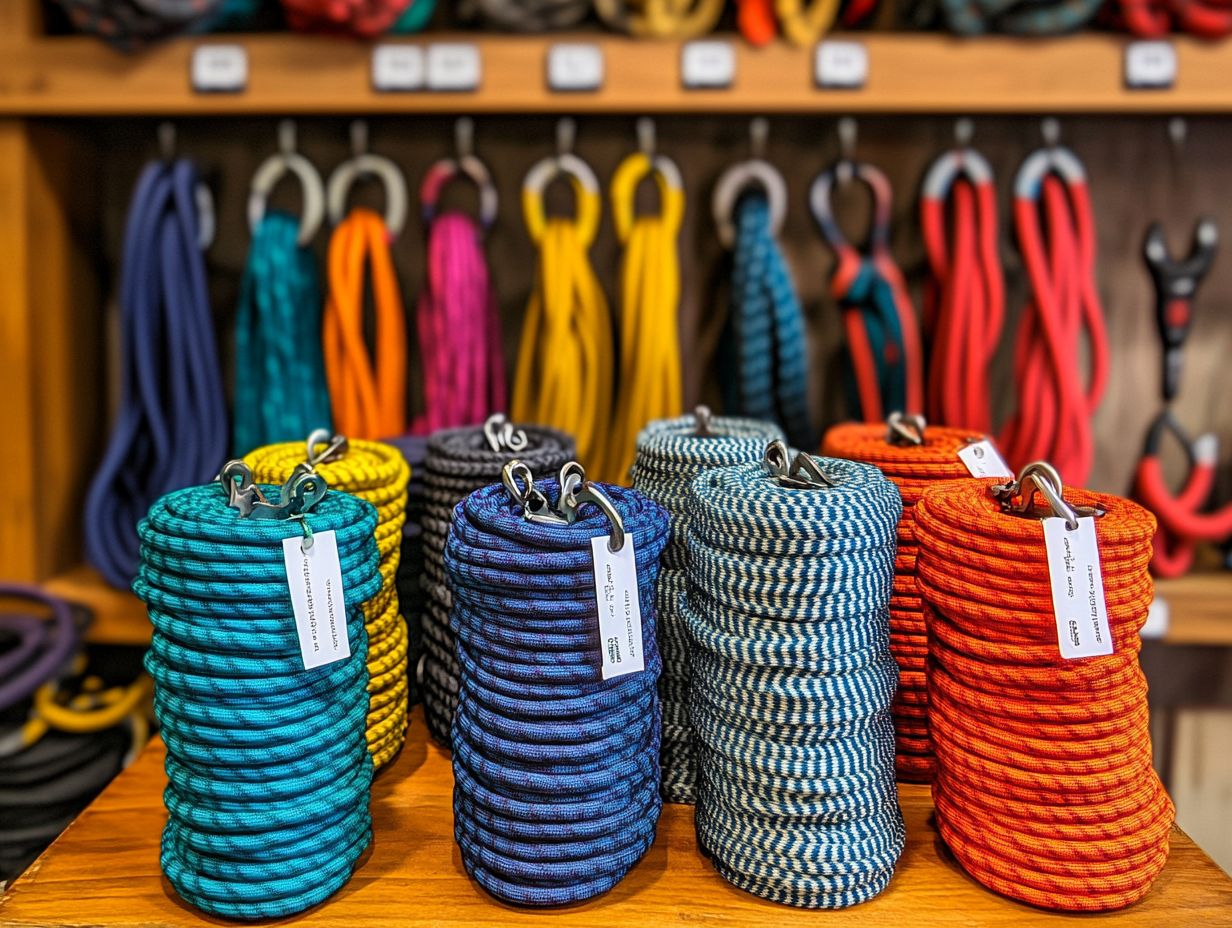
What are the different types of climbing ropes available?
Climbing ropes come in three main types: dynamic, static, and semi-static. Dynamic ropes stretch during falls, while static ropes have little stretch, making them ideal for rappelling.
Semi-static ropes offer some stretch and can be used for both lead climbing and rappelling.
What should I consider when choosing a climbing rope?
When choosing a climbing rope, consider the diameter, length, and type. Diameter affects the weight and durability, while length should match your climbing style.
How do I know what diameter rope to choose?
The diameter, measured in millimeters, impacts energy absorption and climbing performance. Thinner ropes are lighter, ideal for sport climbing, while thicker ropes are more durable for traditional climbs.
What length rope do I need for climbing?
The standard climbing rope length is 60 meters, but they can range from 30-80 meters. Check the route length to ensure you pick the right length.
Do I need different ropes for different types of climbing?
Yes, using the right type of rope is crucial. Dynamic ropes are best for lead climbing, while static ropes work well for rappelling and hauling.
How often should I replace my climbing rope?
Replace your climbing rope every 3-5 years, depending on usage and care. Look for frayed areas or loss of elasticity as signs it s time for a change.

